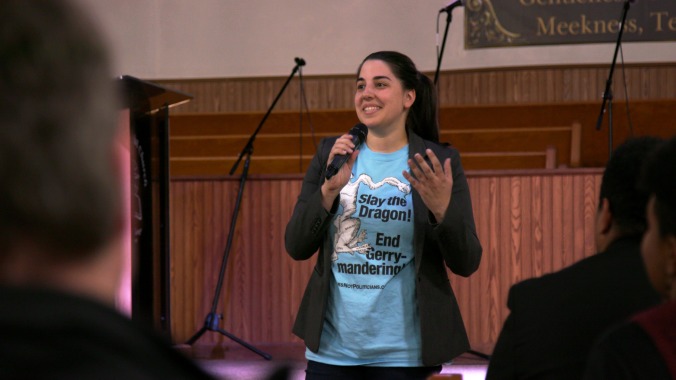That the American electoral system does not privilege the interests of ordinary voters will not come as a surprise to anyone who follows state-level or national politics. But Chris Durrance and Barak Goodman’s documentary Slay The Dragon nonetheless offers an accessible (though hardly involving) explainer on the storied American institution of gerrymandering, with a special focus on REDMAP, the number-crunching project that was behind an assortment of successful Republican efforts to take control of state legislatures in 2010.
At its core is the concept of redistricting—which, like the electoral college, the caucus, and the primary system, mostly serves as a way to turn ostensible representative democracy into an elaborate board game in which the party with the most votes is not necessarily the winner. After every census year, states redraw the boundaries of their election districts to reflect changes in population. In the vast majority of states, the job of creating these new maps falls on state legislators. This effectively means that whatever party controls a state legislature in a census year can protect incumbents and control elections for the next decade. In popular practice, this involves strategies known as “packing” and “cracking.” Packing means putting the opposing party’s base of voters into a handful of oddly-shaped districts; cracking involves breaking up these same populations in order to dilute them with your own base.
Gerrymandering is, of course, nothing new. The term itself is practically ancient, having been first coined in a cartoon published in 1812 by a Boston newspaper that portrayed the shape of one of Massachusetts’s newly redrawn election districts as a long-necked, winged monster. It was dubbed “the Gerry-mander,” a portmanteau of “salamander” and the name of the state’s governor, Elbridge Gerry, who would soon become the fifth vice-president of the United States (and second in a row to die in office). Nor has gerrymandering been limited to election districts. One of the more extreme examples was the 1889 admission of the Dakota Territory as two separate states in order to give the Republican Party more seats in congress—even though the newly created South Dakota consisted in large part of Sioux reservation territory.
The fact that gerrymandering has also been practiced by the Democratic Party is mentioned only in passing in Slay The Dragon. Durrance and Goodman are hardly the first to suggest that the Republicans’ 2010 project, with its extensive investment in state-level races and its use of computer models and data mining, represented a new approach to gerrymandering. To lay out this story (which mostly ignores the history of gerrymandering before the start of this century), they employ a stolid combination of infographics and talking heads; among the latter are David Daley, author of a book on REDMAP, Ratf**ked: Why Your Vote Doesn’t Count, and the architect of REDMAP himself, Chris Jankowski.
Understandably, these parts of Slay The Dragon suffer from a total absence of colorful personalities. Despite its attempts to introduce this or that shadowy figure as a “rockstar” in the field, the world of redistricting consultants is populated exclusively by subspecies of wonk and dweeb; the most interesting thing about them is who gives them money and what they do in secret. But this narrative is still more engaging than the film’s diffuse attempts at profiling two anti-gerrymandering activist groups, the Michigan-based Voters Not Politicians (VNP) and the Wisconsin lawyers and academics behind Gill v. Whitford, which attempted to take gerrymandering to the Supreme Court.
Durrance and Goodman, who are both veterans of PBS’s American Experience, are obviously more comfortable with the informational interview format; these sections of Slay The Dragon are competent, though they never rise to the pizzazz of something like a Vox video. But they seem to be out of their depth when it comes to the watch-and-follow documentary approach. It doesn’t help that, in focusing on Katie Fahey, the founder of VNP, and Ruth Greenwood and Nick Stephanopoulos, a married couple who are involved in Gill v. Whitford, they seem to have mostly come up with footage of speeches, press conferences, and networking events—much of which feels like fundraiser material. One hears variations on the same phrases and soundbites: “The political system no longer works for the average person,” “a new assault on democracy,” and so on.
Has it ever worked for the average person? Slay The Dragon is meant as an urgent call to action ahead of this year’s elections, and it is here that it really falters. It belongs to the school of liberal activism that, like so many campaigns of social conservatism, appeals to a specious imaginary past—a return to normalcy, complete with some lip service to the illustriously useless values of bipartisanship. It rightly addresses Republican-backed voter ID and registration laws, while overlooking other problems of disenfranchisement in the system—like the fact that prison populations factor in the gerrymandering of election districts. For the generation that came of age in the aftermath of Bush v. Gore, it is hard come to the conclusion that this country’s electoral process is fundamentally sound without employing some degree of pretzel logic. But meaningful change involves questioning the whole American project and the undemocratic business of this particular and peculiar democracy. When it all comes down to it, Slay The Dragon has little to contribute aside from a few graphs and moments of teary-eyed celebration.

